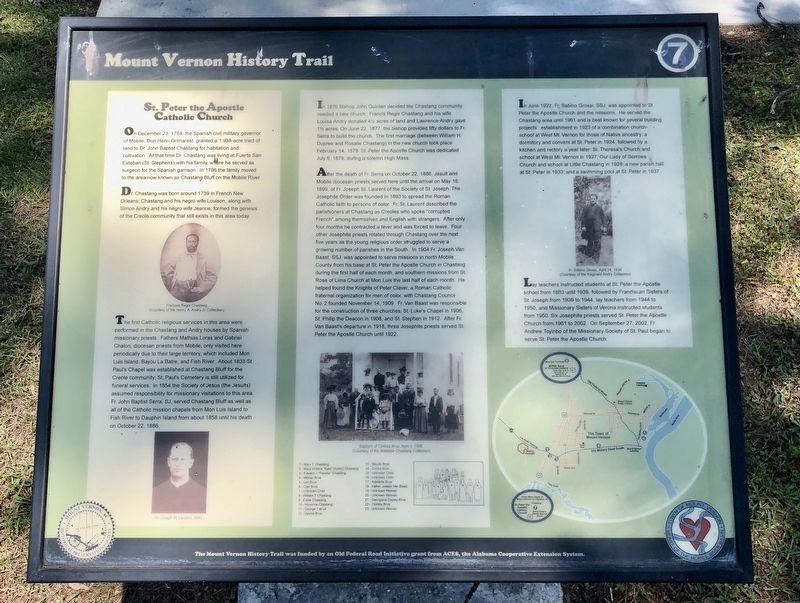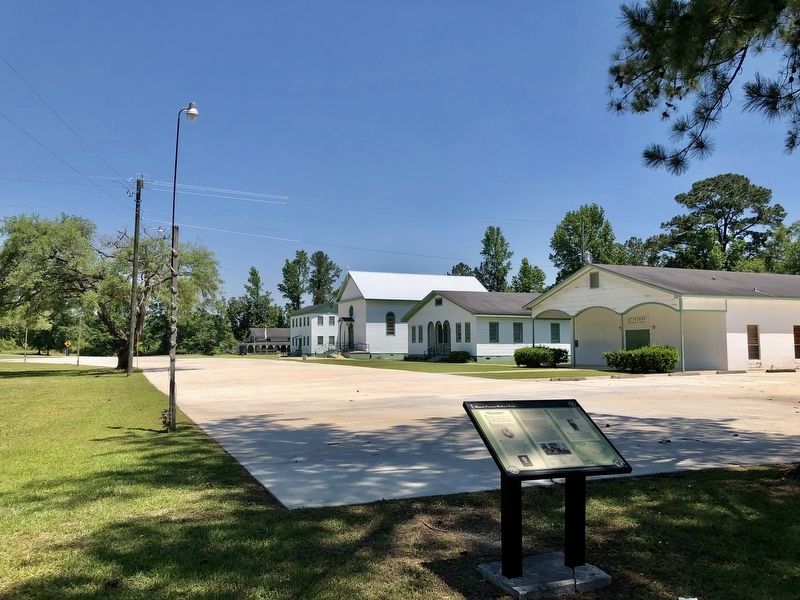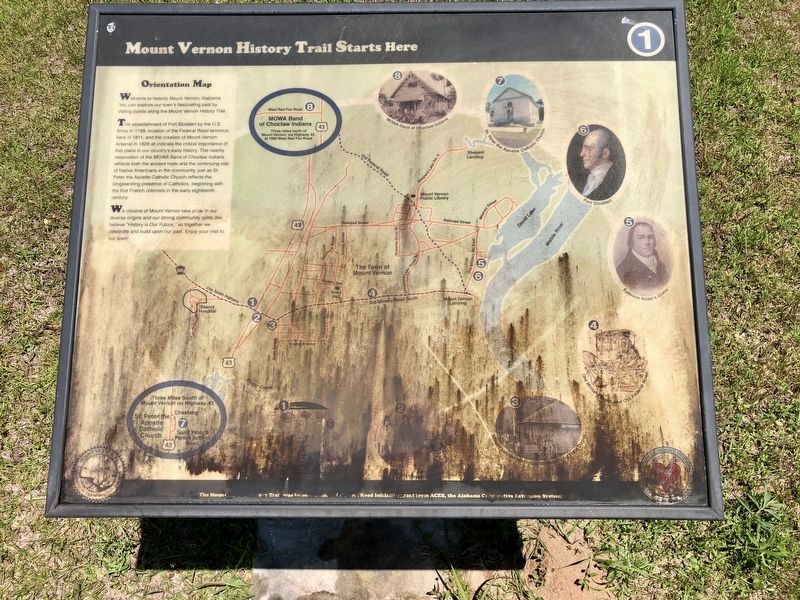Chastang in Mobile County, Alabama — The American South (East South Central)
St. Peter the Apostle Catholic Church
— Mount Vernon History Trail —
Dr. Chastang was born around 1739 in French New Orleans; Chastang and his negro wife Louison, along with Simon Andry and his negro wife Jeanne, formed the genesis of the Creole community that still exists in this area today.
The first Catholic religious services in this area were performed in the Chastang and Andry houses by Spanish missionary priests. Fathers Mathias Loras and Gabriel Chalon, diocesan priests from Mobile, only visited here periodically due to their large territory, which included Mon Luis Island, Bayou La Batre, and Fish River. About 1833 St. Paul's Chapel was established at Chastang Bluff for the Creole community; St. Paul's Cemetery is still utilized for funeral services. In 1854 the Society of Jesus (the Jesuits) assumed responsibility for missionary visitations to this area. Fr. John Baptist Serra, SJ, served Chastang Bluff as well as all of the Catholic mission chapels from Mon Luis Island to Fish River to Dauphin Island from about 1858 until his death on October 22, 1886.
In 1876 Bishop John Quinlan decided the Chastang community needed a new church. Francis Regis Chastang and his wife Louisa Andry donated 4˝ acres of land and Lawrence Andry gave 1˝ acres. On June 22, 1877, the bishop provided fifty dollars to Fr. Serra to build the church. The first marriage (between William H. Dupree and Rosalie Chastang) in the new church took place February 14, 1878. St. Peter the Apostle Church was dedicated July 6, 1879, during a solemn High Mass.
After the death of Fr. Serra on October 22, 1886, Jesuit and Mobile diocesan priests served here until the arrival on May 16, 1899, of Fr. Joseph St. Laurent of the Society of St. Joseph. The Josephite Order was founded in 1893 to spread the Roman Catholic faith to persons of color. Fr. St. Laurent described the parishioners at Chastang as Creoles who spoke "corrupted French" among themselves and English with strangers. After only four months he contracted a fever and was forced to leave. Four other Josephite priests rotated through Chestang over the next five years as the young religious order struggled to serve a growing number of parishes in the South. In 1904 Fr. Joseph Van Baast, SSJ, was appointed to serve missions in north Mobile County from his base at St. Peter the Apostle Church in Chastang during the first half of each month, and southern missions from St. Rose of Lima Church at Mon Luis the last half of each month. He helped found the Knights of Peter Claver, a Roman Catholic fraternal organization for men of color, with Chastang Council No. 2 founded November 14, 1909. Fr. Van Baast was responsible for the construction of three churches: St. Luke's Chapel in 1906, St. Philip the Deacon in 1908, and St. Stephen in 1912. After Fr. Van Baast's departure in 1918, three Josephite priests served St. Peter the Apostle Church until 1922.
In June 1922, Fr. Sabino Grossi, SSJ, was appointed to St. Peter the Apostle Church and the missions. He served the Chastang area until 1961 and is best known for several building projects: establishment in 1923 of a combination church- school at West Mt. Vernon for those of Native ancestry; a dormitory and convent at St. Peter in 1924, followed by a kitchen and rectory a year later; St. Theresa's Church and school at West Mt. Vernon in 1927; Our Lady of Sorrows Church and school at Little Chastang in 1928; a new parish hall at St. Peter in 1933; and a swimming pool at St. Peter in 1937.
Lay teachers instructed students at St. Peter the Apostle school from 1883 until 1939, followed by Franciscan Sisters of St. Joseph from 1939 to 1944, lay teachers from 1944 to 1950,
and Missionary Sisters of Verona instructed students
from 1950. Six Josephite priests served St. Peter the Apostle
Church from 1961 to 2002. On September 27, 2002, Fr.
Andrew Toyinbo of the Missionary Society of St. Paul began to
serve St. Peter the Apostle Church.
Erected by Town of Mount Vernon. (Marker Number 7.)
Topics. This historical marker is listed in these topic lists: African Americans • Churches & Religion. A significant historical date for this entry is February 14, 1878.
Location. 31° 2.29′ N, 88° 1.389′ W. Marker is in Chastang, Alabama, in Mobile County. Marker is at the intersection of St Peter Parish School Road and Chastang Bluff, on the left when traveling north on St Peter Parish School Road. Located off US Highway 43. Touch for map. Marker is at or near this postal address: 16650 US-43, Mount Vernon AL 36560, United States of America. Touch for directions.
Other nearby markers. At least 8 other markers are within 5 miles of this marker, measured as the crow flies. Ellicott's Stone (approx. 2.9 miles away); Mount Vernon Historical Museum and Train Depot (approx. 3.3 miles away); Mt. Vernon Federal Highway (approx. 3.3 miles away); Fort Stoddert (approx. 3.3 miles away); Mt. Vernon Arsenal and Barracks/Searcy Hospital (approx. 3˝ miles away); Mount Vernon Arsenal (approx. 3˝ miles away); Old Military Road and Old Federal Road (approx. 3.9 miles away); a different marker also named Fort Stoddert (approx. 4.4 miles away).
Regarding St. Peter the Apostle Catholic Church. The Josephite Fathers and Brothers or, more properly, Saint Joseph's Society of the Sacred Heart, Inc. (abbreviated post-nominally as S.S.J.) are a society of Catholic priests and brothers, based in the United States; it is a Roman Catholic Society of Apostolic Life of Pontifical Right for Men. It was formed in 1871 by a group of priests from the English Foreign Mission Society of Saint Joseph, also known as the Mill Hill Missionaries. They decided to establish a mission society in the United States dedicated to newly freed people after the American Civil War.
Credits. This page was last revised on July 28, 2021. It was originally submitted on May 3, 2020, by Mark Hilton of Montgomery, Alabama. This page has been viewed 1,705 times since then and 222 times this year. Photos: 1, 2, 3. submitted on May 3, 2020, by Mark Hilton of Montgomery, Alabama.


